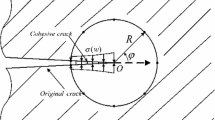Abstract
According to the fictitious crack model, the crack width is infinitely thin at crack initiation and with further loading the crack opens, but no material exists in the cohesive zone. Despite that, the crack is assumed to able to sustain a load. While this is possible at the atomic level, it is not a realistic assumption for the macroscopic behavior we are considering. Invoking the mass conservation law and by postulating a relation between the porosity f of the cohesive zone and the damage variable \(\kappa _{n}\), which is that part of the damage variable \((\kappa )\) that is related to opening of the crack, it is shown that the fictitious crack model can be enhanced so that it accounts for material that is drawn into the cohesive zone. In turn, the amount of material present in the cohesive zone implies a consistent and physically based crack closure criterion. The concepts are first discussed in detail for uniaxial loading and then generalized to arbitrary loadings.
















Similar content being viewed by others
References
Aslani F, Jowkarmeimandi R (2012) Stress–strain model for concrete under cyclic loading. Mag Concr Res 64(8):673–685
Barenblatt GI (1962) The mathematical theory of equilibrium cracks in brittle fracture. Adv Appl Mech 7:55–129
Desai CK, Kumar AS, Basu S, Parameswaran V (2011) Measurement of cohesive parameters of crazes in polystyrene films. In: Proulx T (ed) Proceedings of the 2011 annual conference on experimental and applied mechanics, vol 6. Springer, pp 519–526
Dugdale DS (1960) Yielding of steel sheets containing slits. J Mech Phys Solids 8:100–108
Gopalaratnam VS, Shah SP (1985) Softening response of plain concrete in direct tension. ACI J 82(3):310–323
Hassanzadeh M (1990) Determination of fracture zone properties in mixed mode I and II. Eng Fract Mech 35:845–853
Hillerborg A, Modéer M, Petersson P-E (1976) Analysis of crack formation and crack growth in concrete by means of fracture mechanics and finite elements. Cem Concr Res 6(6):773–782
Hordijk DA (1991) Local approach to fatigue of concrete. Doctoral thesis, Technische Universiteit Delft, Delft, The Netherlands, pp 210
Kambour RP (1973) A review of crazing and fracture in thermoplastics. J Polym Sci Macromol Rev 7:1–154
Kramer EJ (1983) Microscopic and molecular fundamentals of crazing. Adv Polym Sci 52(53):1–56
Kramer EJ, Berger LL (1990) Fundamental processes of craze growth and fracture. Adv Polym Sci 91(92):1–68
Lauterwasser BD, Kramer EJ (1979) Microscopic mechanisms and mechanics of craze growth and fracture. Phil Mag A39(4):469–495
Leuschner M, Fritzen F, van Dommelen JAW, Hoefnagels JPM (2015) Potential-based constitutive models for cohesive interfaces: theory, implementation and examples. Compos B 68:38–50
Needleman A (2014) Some issues in cohesive surface modeling. Procedia IUTAM 10:221–246
Ottosen NS (1986) Thermodynamic consequences of strain softening in tension. J Eng Mech (ASCE) 112(11):1152–1164
Ottosen NS, Ristinmaa M (2013) Thermodynamically based fictitious crack/interface model for general normal and shear loading. Int J Solids Struct 50:3555–3561
Reinhardt HW, Cornelissen HAW, Hordijk DA (1986) Tensile tests and failure analysis of concrete. J Struct Eng (ASCE) 112(11):2462–2477
Sima JF, Roca P, Molins C (2008) Cyclic constitutive model for concrete. Eng Struct 30(3):695–706
Yankelevsky DZ, Reinhardt HW (1989) Uniaxial behavior of concrete in cyclic tension. J Struct Eng (ASCE) 115(1):166–182
Acknowledgments
Stimulating discussions with Adj. Prof. Johan Tryding, Lund University, Sweden and TetraPak, Lund, Sweden are greatly appreciated.
Author information
Authors and Affiliations
Corresponding author
Rights and permissions
About this article
Cite this article
Ottosen, N.S., Ristinmaa, M. Enhanced fictitious crack model accounting for material drawn into the cohesive zone: physically based crack closure criterion. Int J Fract 199, 199–211 (2016). https://doi.org/10.1007/s10704-016-0105-y
Received:
Accepted:
Published:
Issue Date:
DOI: https://doi.org/10.1007/s10704-016-0105-y




